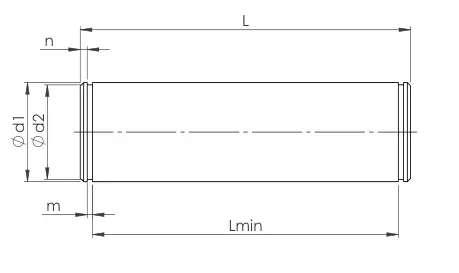Simple Shaft Design

Enter a diameter to see matching plain bearing options
| Property | Base Value | Treated Value |
|---|---|---|
| Tensile Strength (MPa) | - | - |
| Yield Strength (MPa) | - | - |
| Shear Strength (MPa) | - | - |
| Surface Hardness | - | - |
| Treatment Operation | - | |
In shaft design, preventing plastic deformation is key. Therefore, design limits are based on yield strength—the elastic-to-plastic threshold—rather than the higher tensile strength, ensuring safety and durability.
1.1191 (C45) - SAE 1045 - Most popular for general-purpose shafts due to its balance of strength, machinability, and cost.
1.1210 (C50) - SAE 1050 - A higher carbon steel than 1045, offering increased strength and hardness, suitable for applications requiring higher wear resistance.
1.7225 (42CrMo4) - SAE 4140 - Excellent for high-stress shafts, offering superior strength and toughness.
1.6582 (34CrNiMo6) - SAE 4340 - Used for heavy-duty shafts in demanding applications.
1.6523 (21NiCrMo2) - SAE 8620 - Ideal for shafts requiring surface hardening (e.g., carburizing) for wear resistance.
1.0037 (S235JR) - A structural steel used for low-stress shafts where cost is a priority.
1.0577 (S355J2) - Another structural steel, slightly stronger than S235JR, used for moderate-stress shafts.
1.4301 (X5CrNi18-10) - SAE 304 Stainless Steel - Used for shafts in corrosive environments with moderate strength requirements.
1.4401 (X5CrNiMo17-12-2) - SAE 316 Stainless Steel - Similar to 304 but with better corrosion resistance.
1.3505 (100Cr6) - SAE 52100 - Used for high-wear applications like bearings or precision shafts.
3.4365 (AlZnMgCu1.5) - AA 7075 Aluminum - Used for lightweight shafts in low-load applications.
3.7164 (Ti-6Al-4V) - Grade 5 (Titanium Alloy) - Used in high-performance or aerospace applications where weight and corrosion resistance are critical.
1.4542 (X5CrNiCuNb16-4) - SAE Type 630 (17-4PH) - A stainless steel used in corrosive environments with moderate strength requirements.
1.2379 (X153CrMoV12) - D2 Tool Steel - Rarely used for shafts unless extreme wear resistance is required.